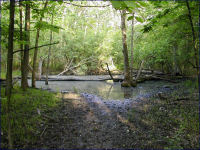
Habitat
Vertigo
tridentata are dispersed throughout many parts of the
eastern half of the United States. They have been located as far
north as Quebec, Cananda to Maine, south to Virginia, all the
way over to Kansas and up to Minnesota and all the states in
between. Summed up, this species is scattered throughout the
midwest and the upper eastern coast and extend as far north as
Canada (Pilsby, 1948,
Nekola, 2008). According to a study
conducted in Wisconsin, five groups of the Honey Vertigo were
observed just south of Green Bay, Wisconsin, which has been the
furthest north this species has been reported in the state of
Wisconsin (Nekola, 2003).
Since V. tridentata is terrestrial and not aquatic, it spends most of it's life low to the ground in an herbaceous or grassy environment. These snails can be found on the forest floor, usually on or underneath a fallen tree and rotting wood or underneath a thicket of fallen leaves. The Honey Vertigo has also been observed on the base of trees and on the stems of plants and weeds a few feet off of the ground. These snails require moisture and humidity so many of the populations live close to a body of water such as a lake, swamp, or marsh (Pilsbry, 1948).
Mr. Wolf, the founder of Vertigo tridentata (Honey Vertigo) in 1870, made a comment on one of his exploring trips where he observed and studied this species of snail. He reported, "abundant in shady copses on green weeds, climbing as high as three feet from the ground. I collected 12,000 (snails) from standing weeds and not one from the ground." (Pilsbry, 1948). I find it fascinating that while on his expedition he could not locate a single Honey Vertigo on the moist ground or in or under rotting wood, but he rather found thousands of these tiny snails on the stems of weeds.
Continue on to learn about the many
Adaptations this species has
evolved for survival.
Or, return to the Home page.
